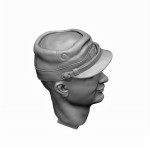



French Head with Kepi – Fz. Kopf mit Kepi M 1884/1914
- Scale / Maßstab: 1/10th
- Approx. width (above ear to ear) / ca. Breite von oberhalb Ohr bis oberhalb Ohr: 16.5mm
- Material: Resin
- Parts / Teile: 2
- Code / Artikel-Nr.: BS11
- Attention: Not a toy. Model kit or model making accessories – not suitable for children under 14 years of age. / Achtung: Kein Spielzeug. Modellbauzubehör – nicht für Kinder unter 14 Jahren geeignet
GPSR Data / Angaben
- Manufacturer / Hersteller: Jon Smith Modellbau
- Responsible Person / Verantwortliche Person
- Address: Hannoverstr. 68, 29664 Walsrode, Germany
- Contact / Kontakt: info@jonsmith-modellbau.com
- Tel: +49 (0)5161 8255
Contents Parts / Inhalt Teile:
- Head (for Kepi) – Kopf (für Kepi)
- Kepi Model 1884/1914
Other Ranks Infantry Kepi Model 1884/1914 / Képi d’Infanterie, modèle 1884/1914: The 2nd, alternative head wears the earlier type M1884 /1914 Kepi in gris bleuté. From the end of 1914, beginning of 1915, one saw more and more French troops wearing the new simplified kepi M1914 version (without piping), but there were still many of the old caps around, especially with reserve and territorial units. The chin-strap and visor were still made out of blackened leather, with Tombac (or sometimes zinc) buttons and black painted vents at each side.
One can display this kepi in at least 2 different coloured versions. Both original items were used as references during the making of this figure. The old-type red regimental numbers on dark-blue backing were often removed from the older, pre-war red kepis and remounted to the new types, giving quite a mixture of headdress colours.
Possible Kepi Colours:
Version 1: Blue kepi with yellow piping. Red sewn-on regimental cloth patch on dark-blue backing.
Version 2: Blue-grey (gris bleuté) kepi with dark-blue piping. Regimental number as in version 1.
There are also versions of this kepi with the regimental numbers showing a dark-blue on light-blue backing cloth. The unit numbers on figure have been modelled slightly more raised than would normally be the case for cloth patches – this is to enable an easier paint finish.
 An deutschsprachige Interessenten:
Sie können mich per eMail oder Telefon auch gerne auf deutsch kontaktieren. Ortsbesuch ist nach Absprache möglich.
An deutschsprachige Interessenten:
Sie können mich per eMail oder Telefon auch gerne auf deutsch kontaktieren. Ortsbesuch ist nach Absprache möglich.
